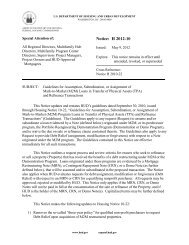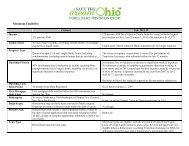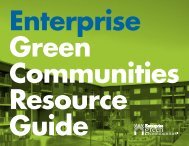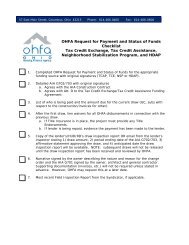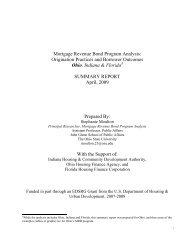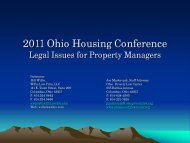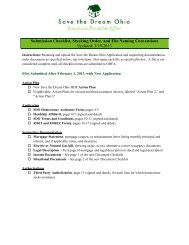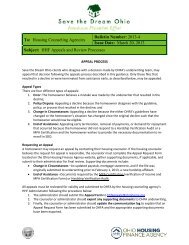3. OWNERSHIPThe owner of a HUD-assisted property is typicallya complex entity representing divergentinterests that must be reconciled before anydecision to convert, sell, or o<strong>the</strong>rwise preserve<strong>the</strong> property can be made. Tax considerations,estate planning, and a variety of o<strong>the</strong>r issues inaddition to property economics can influence<strong>the</strong> decision of <strong>the</strong> ownership entity.OWNERSHIP ISSUES AT A GLANCEIssueLegal StructureManagement StructureOwner MotivationTax ConsiderationsRegulatory StatusBusiness PlanPersonal FactorsLocal LeverageImplications for Preservation StrategyDefines participants in ownership entity and <strong>the</strong>ir relationships.Defines respective rights and interests of participants in ownership entity.May be influenced by purpose of owner’s original investment in <strong>the</strong> housing.Taxes due on sale or under continued ownership can affect owner decisions; mayrequire mitigation strategies."HUD fatigue" or regulatory compliance issues can affect owner motivation.Useful information for predicting owner behavior.Useful information for predicting owner behavior.Useful information for influencing owner behavior.Legal StructureWhat is <strong>the</strong> legal form of ownership? Most subsidizedproperties are owned by limited partnershipsconsisting of one or more general partners(GPs) and any number of limited partners(LPs). The GPs are <strong>the</strong> principals who put <strong>the</strong>deal toge<strong>the</strong>r and control most of <strong>the</strong> decisions;typically one is designated as <strong>the</strong> managinggeneral partner (MGP). The LPs are investorswho bought equity shares and contributed capital(syndication proceeds) to <strong>the</strong> partnership inexchange for tax benefits. These parties havedifferent and often conflicting interests thatmust be reconciled in any transaction.A common ownership arrangement for subsidizedproperties developed or transferred during<strong>the</strong> past 20 years is <strong>the</strong> two-tiered limitedpartnership. The upper tier is an investmentpartnership formed by a syndicator in order toraise pooled equity capital for multiple projects.This may be a public fund involving thousandsof individual investors, or a private syndication.The lower tier is <strong>the</strong> project partnership involvingone or more local GPs. The upper tier investmentpartnership is <strong>the</strong> LP of <strong>the</strong> lower tier projectpartnership. An affiliate of <strong>the</strong> syndicatormay serve as a GP in <strong>the</strong> lower tier as well.While <strong>the</strong> partnership entity typically has title tojust <strong>the</strong> single asset, <strong>the</strong> principals may or maynot have additional holdings. Subsidized housingproperty owners range from actual singleprojectowners, to regional companies with adozen projects, to large national real estateoperators with tens of thousands of units.38Management StructureContractual Authority. Who makes decisions for<strong>the</strong> property? In most cases, prospective buyerswill work with <strong>the</strong> MGP, who controls <strong>the</strong> dayto-daybusiness operations of <strong>the</strong> partnership.But even in partnerships where <strong>the</strong> GPs havesubstantial contractual authority, <strong>the</strong>y are conchapterfour: Researching <strong>the</strong> Property: Towards a Preservation Strategy34
strained by <strong>the</strong>ir fiduciary duty to <strong>the</strong> LPs (consistentwith <strong>the</strong> partnership purpose and applicablelaws), so it's important to know somethingabout <strong>the</strong> LPs as well.Typically, <strong>the</strong> consent of a majority of LP interestsis required for significant decisions, suchas sale or refinancing. In a two-tiered partnership,that means consent of <strong>the</strong> upper tier partnership,which is <strong>the</strong> limited partner. A simplemarket rate conversion with no refinancing typicallyrequires no investor consent.Economic Benefits. Who gets what if <strong>the</strong> propertyis converted or sold? In a typical partnership, <strong>the</strong>GPs get 50 percent or more of <strong>the</strong> residuals fromsale or refinancing—but <strong>the</strong> LPs pay most of <strong>the</strong>exit taxes due on sale (see below) since <strong>the</strong>yhave received most of <strong>the</strong> tax benefits. And <strong>the</strong>LPs may get 50-90 percent of <strong>the</strong> cash flow after<strong>the</strong> 20th year, which could be significant if <strong>the</strong>property converts to market rate. Thus, <strong>the</strong> GPsand LPs may have conflicting interests regarding<strong>the</strong> disposition of <strong>the</strong> property. In a two-tieredpartnership, this web of interests is even morecomplex since profits and losses are pooledacross all <strong>the</strong> projects in <strong>the</strong> fund—which means<strong>the</strong> fate of one project may be determined, inpart, by available options for <strong>the</strong> o<strong>the</strong>rs.Owner MotivationWhat are <strong>the</strong> owners looking for? If <strong>the</strong>y arewilling to sell, do <strong>the</strong>y expect significant equityreturns or just enough cash to cover <strong>the</strong>ir exittaxes? What is <strong>the</strong> timing of <strong>the</strong>ir cash needs?Are <strong>the</strong>y in a hurry or can <strong>the</strong>y wait? If <strong>the</strong> GPhas a significant development deal pending, or<strong>the</strong> LP is driven by year-end tax considerations,<strong>the</strong> seller may need to close before a nonprofitpurchaser can raise <strong>the</strong> necessary funds.Even if detailed information is lacking, a few keyfacts about <strong>the</strong> ownership history and principalscan provide important clues. In terms ofmotivation, most subsidized housing ownersfall into one or more of <strong>the</strong> following categories:Original Owners. These properties are still heldby <strong>the</strong>ir original owner, typically an aging localbuilder or developer who was involved with <strong>the</strong>original construction. Often <strong>the</strong>se owners havebought out, or are in <strong>the</strong> process of buying out,<strong>the</strong>ir limited partners, and partnership decisionmakingis now relatively simple. The familybusiness may be passing on to a new generation.After 20-plus years, <strong>the</strong>se owners mayhave nostalgic attachments to <strong>the</strong>ir propertiesas well as a sense of economic entitlement thatmust be addressed. Personal and political considerationsfor this group tend to be important.Tax-Motivated Purchasers. These propertieswere bought and resyndicated prior to federaltax reform in 1986. The owners' anticipated taxbenefits never materialized, and <strong>the</strong> propertiestypically suffer from deferred maintenance dueto a lack of ongoing investment. The ownerstend to be large national operators. These ownersare often eager to sell, but <strong>the</strong>ir exit taxesmay exceed <strong>the</strong> available cash proceeds, especiallyif <strong>the</strong>re are secondary note holders. (SeeFinancial.)Conversion-Motivated Purchasers. These propertieswere purchased more recently in anticipationof prepayment and/or market-rate conversion.The owners may have invested substantialcash in anticipation of future equity gains. Theymay have little interest or experience in subsidizedhousing or in <strong>the</strong> housing business generally.Some recent large-scale transactions inwhich entire subsidized housing portfoliosinvolving thousands of units were bought outby large non-housing conglomerates and <strong>the</strong>nquickly put on <strong>the</strong> auction block for resale mayfall into this category.Affiliated Management Companies. In additionto o<strong>the</strong>r motivations, many owners who alsomanage <strong>the</strong>ir properties value <strong>the</strong>ir managementfee interests beyond <strong>the</strong> dollar amount of<strong>the</strong> contract, especially if it is a family businessor an extensive operation. Where <strong>the</strong>re is identityof interest management, owners are oftenreluctant to sell—unless <strong>the</strong>y can keep managementas part of <strong>the</strong> transaction.Tax ConsiderationsAn owner's decision to prepay, convert, refinance,or sell may be driven by tax considerationsas much as cash benefits. The major taxissues affecting subsidized properties are asfollows:35 chapter four: Researching <strong>the</strong> Property: Towards a Preservation Strategy39



